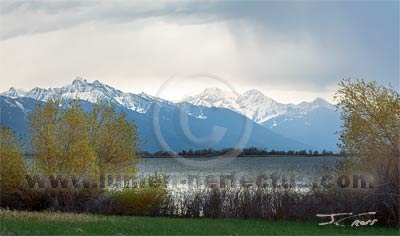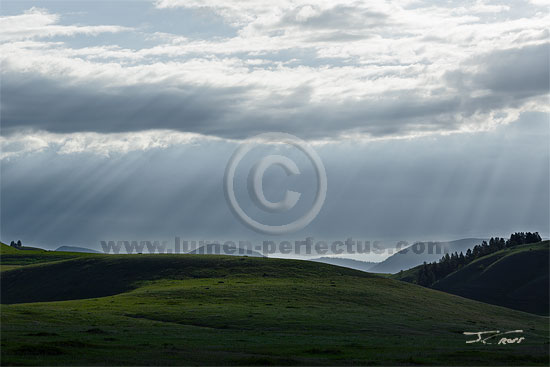www.lumen-perfectus.com
Focus
“If you're going to chop an onion, chop and onion.”
Michael Pollen
Sometimes your head's in the game, sometimes it's not. If you're making snapshots, taking pictures at your kid's birthday party, or otherwise just having fun with a camera, in may not matter. When making outdoor photographs for fine-art prints, especially if you do this for a large portion of your income, the difference is significant. It's necessary to maintain focus, to be “in the moment” when working in the field.

Winter blahs: a mid-March snapshot of the view from our home.
I love photographing in winter. That is, when it's winter-like in winter. During the 2012/2013 winter here in western Montana the snow stopped about mid-January. A warm period melted much of our snow cover, leaving only bare ground between patches of decaying snow. Then it got cold and stayed that way. The result? Gray. Lots of gray. From the middle of January until early May, the sky: gray. The waters of Flathead Lake, Lake McDonald, and local streams and rivers: gray. The mountains all around us: gray. A flat, unappealing gray that, even with slate blue and dull brown tones mixed in, made it a difficult time for me photographically. I found little motivation; the conditions made it quite challenging to be creative. I spent much of the winter indoors, making prints (mostly contract printing of client pictures), working on my older photo files and the very few new pictures, honing Photoshop skills. That's all necessary and fine, but I discovered one can become quite rusty, losing important behind-the-camera skills, when those conditions persist.
One day in early May, a Tuesday, I think, just about noon, things suddenly became green. Spring had sprung. The high clouds were gorgeous, the mountains and local hillsides had begun greening up, the quality of morning and evening light had changed from flat to beautiful. Migratory birds were arriving, some to stay for the summer, others stopping briefly before moving on to breeding grounds farther north. Squirrels and chipmunks chattered everywhere. Our resident herd of whitetail deer had begun shedding their dull winter coats, making way for the classic “tawny” color we see in the warmer months. Beauty and creative motivation, abundant once more, pulled me away from the computer and into the outdoors with my camera.
Almost Entirely Not Really There
An appointment in a town 20 miles (32 km) south of home led to a stop along the way at the Pablo National Wildlife Refuge. The refuge offers some lovely views of the Mission Mountain Range, while its reservoir hosts native birds and migrant trumpeter swans, snow geese, white pelicans, and more. On this day, beautiful early sunlight over the mountains lit a storm approaching from the west. I arrived at the reservoir about 8:00 AM, giving me three hours before my appointment farther south. Being familiar with the area, I'd already chosen my location, so I needed little time to set up my gear. Abundant mud blanketed the lake shore; I could find no interesting foregrounds for the mountain photos I had in mind. The storm, arriving as I set up, brought little rain, but the clouds reduced visibility and diminished the mountains. The sun frequently peeked through, lighting the budding trees for a few seconds before fading away.

Northwestern Montana's Pablo NWR, virga over the Mission Mountains.
I wandered the area, returned to the car, drove to another spot, wandered some more. Because of my appointment, I tried to avoid collecting too much mud on my boots. A potentially nice composition required standing a few feet out into the water of the reservoir; for this brief visit I hadn't equipped myself to do that.
My appointment nagged at me, messing with a nice photo opportunity. My usual focus and concentration failed me; I felt jittery, out of place. I couldn't work as I usually do, immersing myself in the process, observing, seeing, solving the little problems that can prevent getting good photographs. Still, I enjoyed being outdoors, walking the refuge, watching the light change, looking at the mountains. Some of the pictures I got weren't terrible, but in the end I gave it up, leaving without the “keeper” photo I'd hoped for.
I continued on to my appointment, took care of business (which, fortunately, went very well, so the day wasn't a complete loss), returning home by early afternoon. I couldn't help but be disappointed in the morning. A photo waited to be made that day, but I'd missed it. I couldn't get it done.
Four Days Later
The following Monday my wife left for work as usual, about 7:30 AM. From home we have good views of the sky to the north, west, and south-west. Clouds were heavy in those directions. Local hills to the east and south block our view of the Mission Range and Flathead Lake (map). As Pat reached US 93 and drove south toward Polson she could see the sun and sky over the lake and mountains to the east. She called from the car to suggest I get out quickly to capture what she could see through her windshield. As those kinds of conditions rarely last more than a few minutes, I'd need to move fast!
I grabbed my photo gear and a jacket, flew out the door, and drove a little more than mile to a nice view of local hills and a sky full of god-beams. After parking the car I ran a hundred yards to a clear view, set up my tripod, and went to work. While still a beautiful scene, the sky had already changed, losing much of the color from just a few minutes earlier. I worked the scene quickly, moving around, getting the obvious compositions, some less obvious ones (I hope!) and even capturing a few frames to later stitch into a wide panorama. I composed to keep the sun, far too bright to manage, outside (above) the frame. The light and shadow on the local hills was stunning. My position minimized the mountains beyond those hills, but gave me plenty of sky to play with.
It lasted no more than 15 minutes, the fantastic light disappearing as the sun climbed behind the fast-moving clouds. For that brief period I was fully engaged, completely in the moment, my world reduced to the scene around me. There were no distractions, nothing in my mind but working the scene, capturing the image, visualizing the print I'd make. It was wonderful! When it ended I walked back to the car, almost certainly with a big smile on my face. It would be several hours before I'd see the resulting photos, but I knew I'd got something good.

Godbeams over local hills, with the Mission Mountains hiding beyond.
Infinite Monkeys
Many factors must come together to create a great photograph. Photography combines technology and art; the two can't be separated. The technology can be mastered by most of us. Art is a bit more nebulous, much more difficult to define. Of course one can be lucky, arrive at the right place at the right time, point and shoot, and get a great photo. One can also shoot a thousand photos a day for decades, insuring a keeper now and then. It's the infinite monkeys theorem, proven by a few of the millions of smartphone photos uploaded to the Web every day.
I never complain when I get the occasional lucky shot; it does happen. One of my best-selling prints is just that, a grab shot, and one I almost didn't take. But I'm far more likely to be happy with my efforts when I'm able to concentrate, focus, and be fully engaged in the work, when I set out to make a picture, and do nothing but make a picture.
May, 2013
Note: As I've said before, I'm sorry about the big © in the middle of the pictures. I hate doing this, and dislike the mess it makes of the images. But I constantly find my pictures all over the Web, often using my bandwidth to display them. There's very little that can be done to stop this violation of my copyright, but I've found when I insert the watermark, the images are virtually never stolen. Therefore I continue to do this.
All products and brand names mentioned are trademarks or registered trademarks of their respective owners.